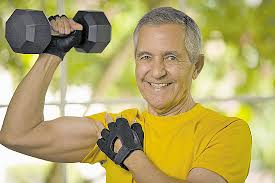Aging is inevitable; losing your strength and ability to perform daily activities doesn’t have to be. Sarcopenia is a term used to describe the age-related progressive loss of muscle mass and strength. The process begins in your 40s and ramps-up between the ages of 65 and 80. While age-related strength loss is normal, sarcopenia speeds up the loss of muscle mass and can reduce your muscle mass by 8% each decade. Factors such as insulin resistance, obesity, loss of mobility, and inactivity contribute to the progressive loss of muscle mass in older adults and as a result increase the risk for falls and make daily activities difficult to perform.
Sarcopenia is often diagnosed with the following mnemonic:
S – strength (loss of strength)
A – assistive device (use of a device for walking)
R – rising from a chair (difficulty standing from a chair without use of hands)
C – climbing stairs (difficulty with stair climbing)
F – falls (presence of falls in the last year)
Aging might suddenly sound daunting, but it doesn’t have to be as long as you stay moving! Improving your strength and staying active reduces your risk at developing sarcopenia and also improves your quality of life. Strength training alone can improve your ability to complete daily activities, protect your joints from injuries, improve your balance, and reduce your risk for falls. It can also enhance your thinking skills, improve bone density (to reduce risk for osteoporosis), and help manage chronic conditions such as diabetes, heart disease, and depression.
Strength training as you age doesn’t have to be difficult. Research shows that exercising even just 2-3x per week can enhance muscle mass and strength. Ideally, 2-3 sets of 1-2 exercises for each major muscle group should be performed. If the “ideal” situation doesn’t exactly match your lifestyle, try starting small and just get moving! Any physical activity is better than no physical activity, because even small steps lead to big changes. Try walking more often, getting up out of your chair repetitively to build leg strength, lifting small weights, or joining a fitness class at your local facility; make the change to live a longer healthier life!

